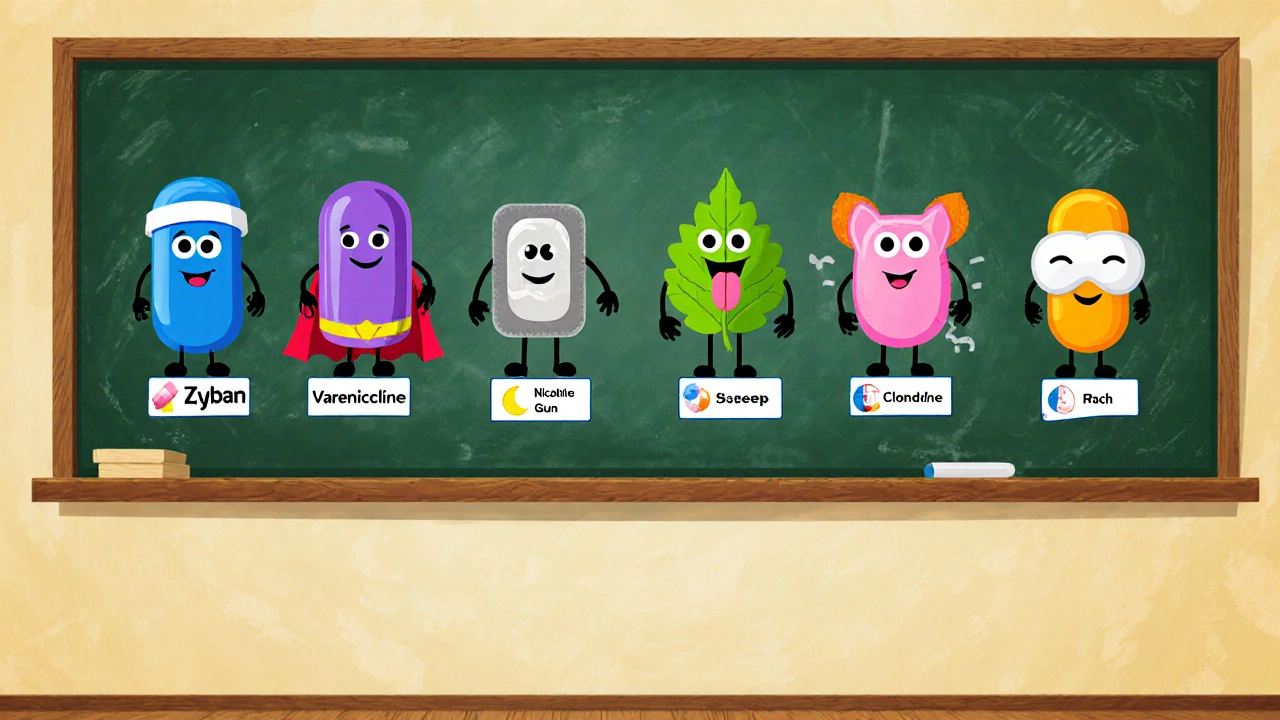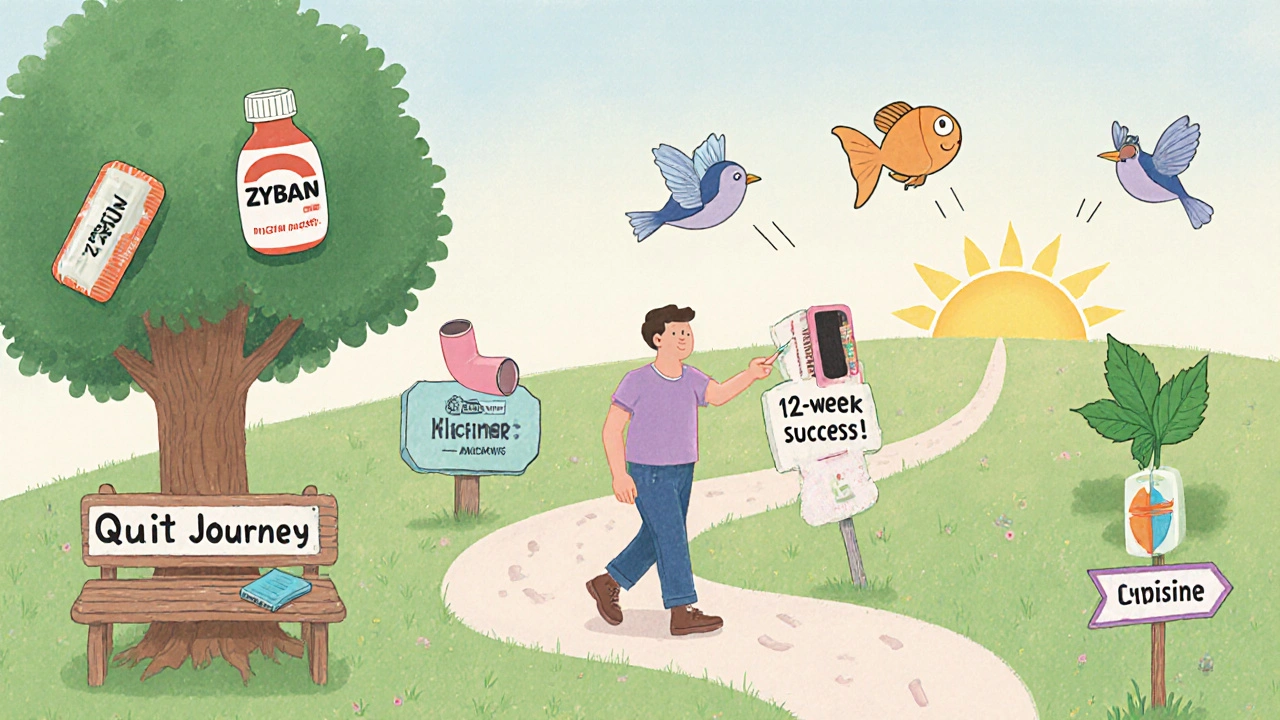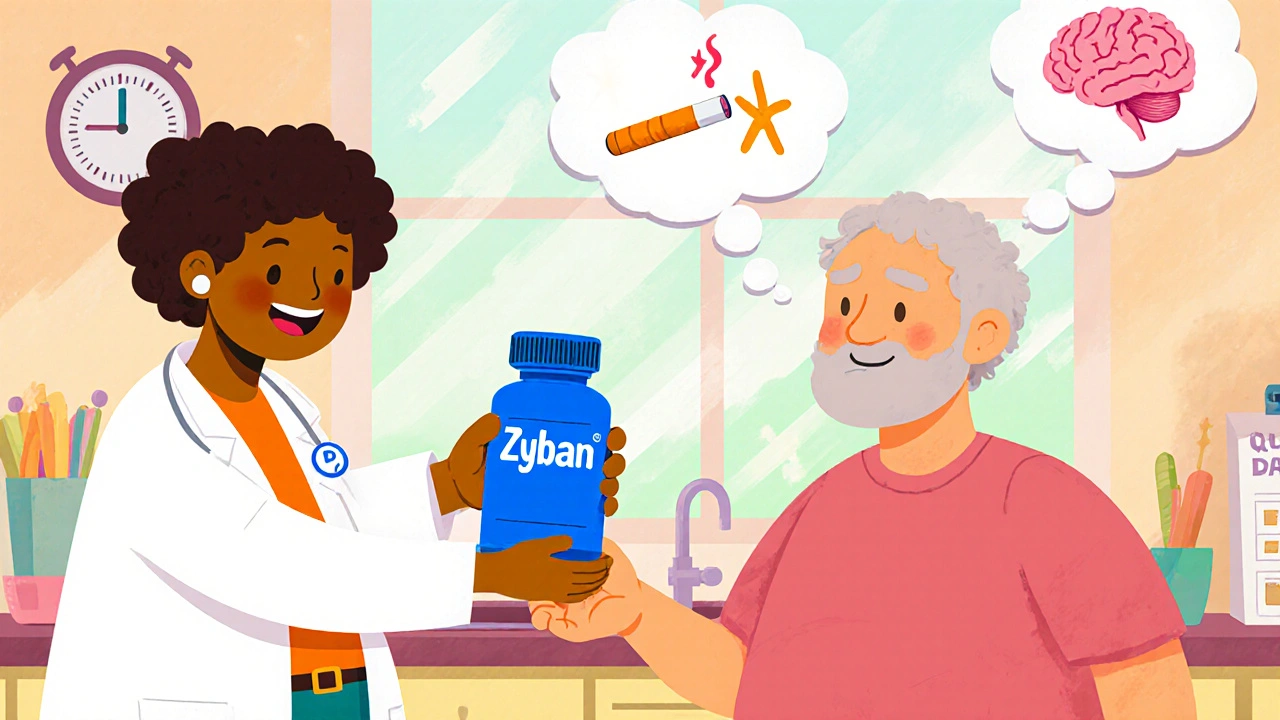Smoking Cessation Medication Selector
Find Your Best Quit Smoking Medication
Answer a few questions about your needs and preferences to find the smoking cessation option that's right for you. Based on the latest clinical evidence and your individual circumstances.
If you’re trying to quit smoking, you’ve probably heard of Zyban. It’s one of the few non‑nicotine pills on the market, and many people wonder whether it beats the more familiar nicotine‑replacement options or newer drugs like varenicline. This guide walks you through how Zyban works, who should consider it, and how it stacks up against the most common alternatives.
Quick Takeaways
- Zyban (bupropion) is a prescription antidepressant that also reduces nicotine cravings.
- Its quit‑rate (≈20‑30%) sits between nicotine‑replacement therapy (NRT) and varenicline (≈30‑40%).
- Common side effects include insomnia, dry mouth, and a small risk of seizures.
- Best for smokers who prefer a pill, have a history of depression, or can’t tolerate nicotine patches.
- When cost, insurance coverage, or side‑effect profile matters, NRT or varenicline may be a better fit.
How Zyban Works
When you first see the name Zyban, you might think it’s a nicotine gum in disguise. In reality, it’s the brand name for bupropion, a dopamine‑ and norepinephrine‑reuptake inhibitor originally approved as an antidepressant. By boosting those neurotransmitters, Zyban blunts the reward signal you get from nicotine, making cravings feel less urgent.
The drug is started two weeks before your quit day, giving blood levels time to stabilize. You take a 150 mg tablet each morning for the first three days, then step up to 150 mg twice daily. The typical course lasts 7-12 weeks, though some clinicians extend treatment if cravings linger.
When to Consider Zyban
Not every smoker is a good candidate. Here are the classic “yes” signals:
- You’ve tried nicotine patches or gum and still relapsed.
- You have a history of depression or seasonal affective disorder-bupropion can help mood while you quit.
- You prefer a pill over a patch or a chewing gum.
- You’re allergic to nicotine or find the taste of gum intolerable.
Conversely, avoid Zyban if you have a seizure disorder, are currently on a monoamine‑oxidase inhibitor (MAOI), or have uncontrolled high blood pressure. Always run a quick screen with your GP before starting.
Overview of Common Alternatives
Below is a snapshot of the main rivals you’ll meet in a pharmacy or online.
- Varenicline (brand name Chantix) - a partial nicotine‑receptor agonist that both blocks nicotine’s effect and reduces cravings.
- Nicotine patch - a transdermal patch delivering a steady dose of nicotine over 16‑24 hours.
- Nicotine gum - chewable nicotine replacement you control by timing and intensity of chewing.
- Cytisine (sold as Tabex in some markets) - a plant‑derived alkaloid that binds to the same receptors as nicotine.
- Clonidine - an off‑label antihypertensive that eases withdrawal symptoms.
- Nicotine inhaler - a hand‑held device that delivers nicotine vapor, mimicking the hand‑to‑mouth ritual.

Side‑Effect Profiles at a Glance
Side effects often decide which medication you’ll stick with. Here’s a quick rundown:
- Zyban - insomnia, dry mouth, headache, rare seizures.
- Varenicline - vivid dreams, nausea, mood changes (rare psychiatric warnings).
- Nicotine patch - skin irritation, vivid dreams if worn overnight.
- Nicotine gum - throat soreness, hiccups, jaw fatigue.
- Cytisine - mild nausea, occasional dizziness.
- Clonidine - drowsiness, dry mouth, low blood pressure.
Cost and Accessibility
Money matters, especially if you rely on the NHS or private insurance. Rough UK 2025 figures (rounded):
- Zyban - £25‑£30 per 30‑day box (often covered on prescription).
- Varenicline - £60‑£80 for a 12‑week pack (sometimes subject to prescribing restrictions).
- Nicotine patch - £25‑£35 for a 4‑week supply (over‑the‑counter).
- Nicotine gum - £15‑£20 for a 200‑piece box.
- Cytisine - £10‑£15 for a 30‑day course (available via specialist pharmacies).
- Clonidine - £5‑£10 for a month’s tablets (requires GP prescription).
Head‑to‑Head Comparison Table
| Medication | Mechanism | Typical quit‑rate* | Common side effects | Prescription needed? | Estimated UK cost (12 weeks) |
|---|---|---|---|---|---|
| Zyban (bupropion) | Dopamine & norepinephrine reuptake inhibition | 20‑30 % | Insomnia, dry mouth, rare seizures | Yes | ≈£30‑£40 |
| Varenicline | Partial nicotine‑receptor agonist | 30‑40 % | Nausea, vivid dreams, mood changes | Yes | ≈£70‑£90 |
| Nicotine patch | Transdermal nicotine delivery | 15‑25 % | Skin irritation, sleep disturbances | No | ≈£30‑£40 |
| Nicotine gum | Buccal nicotine absorption | 15‑20 % | Throat soreness, hiccups | No | ≈£15‑£20 |
| Cytisine | Partial agonist at α4β2 receptors | 20‑25 % | Nausea, mild dizziness | Prescription (specialist) | ≈£12‑£18 |
| Clonidine | Alpha‑2 adrenergic agonist reducing withdrawal | 10‑15 % | Drowsiness, low BP | Yes | ≈£5‑£10 |
*Quit‑rates are based on meta‑analyses published between 2020‑2024 and can vary by study design.
Choosing the Right Option for You
Pick a medication the way you’d pick a tool for a DIY project - match the job to the tool.
- If you hate nicotine in any form: Zyban or varenicline are the only true non‑nicotine pills.
- If you need a slow, steady dose: The patch gives a constant nicotine level without the need to remember multiple doses.
- If you love the “hand‑to‑mouth” habit: Gum or the inhaler let you mimic smoking rituals.
- If cost is a major barrier: Cytisine and clonidine are the cheapest, but you’ll need a prescriber willing to order them.
- If you’ve tried one medication and failed: Switching to a different class often re‑sets the brain’s conditioning.
Don’t forget to pair medication with behavioral support - counseling, apps, or quit‑lines raise success rates by 10‑15 % across the board.

Practical Tips for a Successful Quit Attempt
- Set a firm quit day at least two weeks after starting Zyban or varenicline.
- Notify friends, family, and coworkers; ask them to hold you accountable.
- Keep nicotine‑free snacks (carrots, nuts) handy to fight oral cravings.
- Track cravings in a journal - note time, intensity, and what you were doing.
- If you experience insomnia on Zyban, try taking the second dose earlier in the day.
- Stay active - short walks or light exercise can reduce withdrawal spikes.
- Know the signs of a rare seizure (muscle twitching, loss of consciousness) and seek help immediately.
Potential Pitfalls and How to Avoid Them
Even the best medication can flop if you run into avoidable snags.
- Skipping the two‑week lead‑in: Starting Zyban too close to your quit day leaves you without therapeutic levels.
- Mixing nicotine patches with Zyban: The combined nicotine load can cause nausea and heightened blood pressure.
- Ignoring side‑effects: If insomnia persists, discuss dose timing with your doctor rather than just stopping.
- Discarding behavioral support: Medication alone is rarely enough for heavy smokers (10+ cigarettes/day).
Bottom Line
Zyban offers a solid middle ground: it’s prescription‑only, works without nicotine, and has a modest quit‑rate. Varenicline edges out on efficacy but carries more psychiatric warnings. NRT options remain the cheapest and easiest to obtain, but they keep nicotine in your system. Cytisine and clonidine provide low‑cost alternatives for specific cases.
Talk to your GP, weigh the side‑effect profile, consider your budget, and pick the approach that fits your lifestyle. The right combo of medication and support can turn the daunting task of quitting into a doable 12‑week plan.
Frequently Asked Questions
Can I use Zyban and nicotine patches together?
Generally no. Combining a nicotine patch with Zyban can raise nicotine levels too high, leading to nausea, dizziness, and higher blood pressure. If you already have a patch, discuss a safe taper plan with your doctor before adding Zyban.
How long should I stay on Zyban after quitting?
Most clinicians recommend 7-12 weeks total. Some people extend to 6 months if cravings linger, but the benefit diminishes after the first three months.
Is Zyban safe for people with a history of depression?
Yes, and it can actually improve mood for many. However, monitor any worsening symptoms and keep a mental‑health professional in the loop, especially during the first two weeks.
What makes varenicline more effective than Zyban?
Varenicline binds directly to the nicotine receptors, blocking nicotine’s “high” while still providing a mild stimulus that eases cravings. Zyban works indirectly by altering brain chemistry, which is why its quit‑rate is a bit lower.
Can I switch from Zyban to varenicline if I’m not succeeding?
Yes. A brief wash‑out period (usually 48 hours) reduces the risk of additive side effects. Your GP can set up the new prescription and advise on timing.






15 Comments
Quitting smoking is a huge step and you’re already doing the heavy lifting by researching your options. Zyban can be a solid choice especially if you’ve struggled with nicotine patches in the past. It works on brain chemistry so you won’t be dealing with nicotine cravings in the same way. Keep an eye on sleep patterns because insomnia is a common side effect, but many people find that taking the second dose earlier in the day helps. Pair the medication with a quit‑line or counseling for the best chance of success
Listen, the pharma giants don’t want you to know that Zyban is just a disguised mood‑enhancer, a tool to keep you dependent on another pill while they milk the system. They pair it with nicotine patches in secret trials and hide the seizure risk behind fine print. It’s like a covert operation inside your prescription bottle. Don’t be fooled by the “non‑nicotine” label, they’re still pulling strings in the background. The whole quit‑program industry is a circus and you deserve transparency
From a pharmacodynamic perspective, bupropion’s norepinephrine-dopamine reuptake inhibition modulates the mesolimbic reward pathway, attenuating the reinforcement mechanisms associated with nicotine. Clinically, initiating a titration phase two weeks prior to D‑day aligns plasma concentrations with the target therapeutic window, optimizing abstinence rates. Incorporating behavioral activation strategies alongside the medication further synergizes neurochemical modulation with psychosocial resilience. Monitoring for insomnia and adjusting dosing time constitutes a pragmatic approach to adverse event mitigation. Ultimately, a multimodal protocol encompassing the pharmacological agent, CBT‑I, and relapse‑prevention planning yields the most robust outcomes
The patch delivers a steady nicotine flux, which can blunt withdrawal but does not address the underlying neurochemical dependency. Its simplicity makes it appealing for many users.
Oh brilliant, because paying twice for a nicotine delivery system and a placebo‑like antidepressant is exactly the hallmark of sophisticated healthcare. One would think the NHS budget committee drafted this masterpiece during a coffee break. Cheers to the ingenuity of subsidizing mediocrity.
We have a collective responsibility to protect ourselves from the corporate poison that is nicotine, and Zyban offers a noble path away from that shackles. It is not merely a pill; it is a statement of defiance against the greed of tobacco conglomerates. By choosing a non‑nicotine option you reject the cycle of exploitation that has plagued generations. Let us champion this ethical alternative and inspire others to break free from the smoke‑filled tyranny.
Hey, I get how overwhelming all these choices can feel. If you decide to go with Zyban just remember to set a routine – same time, same place – it really helps the body adjust. Talk to your doctor about any sleep issues early on, they’ll tweak the schedule. You’re not alone in this, there are plenty of support groups online that check in daily.
The hollow promise of “just take a pill” often masks the silent despair that creeps in when cravings strike at 3 am. Zyban may quiet the chemical storm, but the emotional vacuum remains, sucking the joy from moments you once cherished. It is a bitter pact – you trade one dependency for another, unseen but equally binding. Accept the darkness, but do not surrender your will.
In the grand tapestry of human habit, smoking is but a thread of fire woven into our daily rituals. Removing that thread with Zyban is akin to plucking a stitch; the fabric may fray before it settles into a new pattern. One must contemplate the existential weight of cravings, for they are mirrors reflecting deeper anxieties. Yet, as we stare into that mirror, we may discover that the true battle is not against nicotine, but against the fear of silence.
Alright, let’s break this down step by step so you can see why Zyban might just be the superhero you didn’t know you needed in your quit‑smoking saga. First off, the drug hits the brain’s dopamine and norepinephrine highways, giving you a mental boost that feels like a mini‑pep rally against cravings. Second, because it’s a pill, you avoid the sticky taste and gum‑chewing gymnastics that many find downright annoying. Third, the two‑week lead‑in period lets your system settle, which means you won’t be scrambling on quit day with a half‑formed plan. Fourth, the typical side‑effect roster-insomnia, dry mouth, occasional headache-are usually manageable with simple lifestyle tweaks like hydrating and adjusting your bedtime. Fifth, studies from 2022‑2024 show quit‑rates hovering around the sweet spot of 20‑30 %, comfortably above nicotine patches and just shy of varenicline’s top tier. Sixth, the cost in the UK sits at a reasonable £25‑£30 for a month’s supply, making it accessible for most budgets. Seventh, you can pair Zyban with behavioral support-apps, counseling, or even a buddy system-to kick those cravings to the curb. Eighth, many users report a mood lift, which is a pleasant side bonus when battling the emotional rollercoaster of quitting. Ninth, the risk of seizures is real but astronomically low for anyone without a seizure disorder, so a quick medical screen clears the path. Tenth, if insomnia creeps in, moving the second dose earlier in the day often does the trick without compromising efficacy. Eleventh, the medication’s non‑nicotine nature means you aren’t substituting one addiction for another, a psychological win in itself. Twelfth, pharmacies often have the prescription ready for a quick pick‑up, so no long waiting periods. Thirteenth, the pill format fits neatly into daily routines-morning coffee, evening wind‑down-making adherence a breeze. Fourteenth, the literature emphasizes that a combined approach (medication plus counseling) can lift success rates by an extra ten percent, a statistic you can’t ignore. Fifteenth, if you find Zyban isn’t cutting it, you have the flexibility to switch to varenicline after a short washout, keeping your options open. And finally, the most compelling reason: you get to reclaim control over your life without the lingering taste of smoke, stepping into a future where you dictate your health, not a pack of cigarettes.
Your insistence on dissecting every nuance of the quit‑smoking pharmacology is admirable, yet it risks paralyzing action with endless analysis. When you commit to a medication like Zyban, the real work begins at the behavioral level – establishing triggers, building new habits, and confronting the psychological grip of nicotine. The data shows that adherence to the dosing schedule dramatically influences success, so set alarms, keep a pillbox, and treat the regimen like a non‑negotiable appointment. Remember, the medication is only a catalyst; your mindset and support network supply the fuel that ultimately drives the change.
Contemplating the choice between a non‑nicotine pill and a nicotine patch feels like weighing freedom against familiarity; each path carries its own philosophy of cessation.
While many laud Zyban for its dual antidepressant and anti‑craving properties, the evidence also highlights a notable dropout rate due to insomnia and dry mouth. If you’re already prone to sleep disturbances, consider scheduling the second dose earlier or opting for a nicotine‑replacement method that doesn’t interfere with nocturnal rest. Moreover, the cost differential, though modest, can become significant over a prolonged course, especially if insurance coverage is limited. Ultimately, a personalized assessment with your clinician should dictate whether the pharmacological benefits outweigh the potential inconveniences.
Choosing a quit method should fit your lifestyle and budget.
It is imperative, therefore, to evaluate both efficacy and side‑effect profiles, because a higher quit‑rate may be offset by adverse events, such as insomnia or vivid dreams, which can compromise adherence; similarly, the financial burden, although seemingly modest, must be weighed against long‑term health benefits, especially in the context of public health economics.